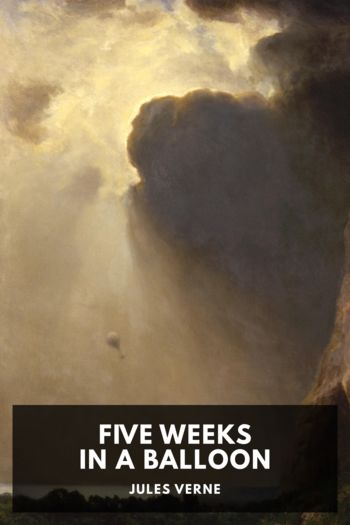From the Earth to the Moon, Jules Verne [beach books .TXT] 📗

- Author: Jules Verne
Book online «From the Earth to the Moon, Jules Verne [beach books .TXT] 📗». Author Jules Verne
The newspapers published these reflections with a thousand commentaries, and did not fail to tell the public that it must arm itself with angelic patience.
On the 8th no change. On the 9th the sun appeared for a moment, as if to jeer at the Americans. It was received with hisses, and wounded, doubtless, by such a reception, it was very miserly of its rays.
On the 10th no change. J. T. Maston nearly went mad, and fears were entertained for his brain until then so well preserved in its gutta-percha cranium.
But on the 11th one of those frightful tempests peculiar to tropical regions was let loose in the atmosphere. Terrific east winds swept away the clouds which had been so long there, and in the evening the half-disc of the moon rode majestically amidst the limpid constellations of the sky.
A New StarThat same night the news so impatiently expected burst like a thunderbolt over the United States of the Union, and thence darting across the Atlantic it ran along all the telegraphic wires of the globe. The projectile had been perceived, thanks to the gigantic reflector of Long’s Peak.
The following is the notice drawn up by the director of the Cambridge Observatory. It resumes the scientific conclusion of the great experiment made by the Gun Club:—
“Long’s Peak, December 12th.
“To the Staff of the Cambridge Observatory—The projectile hurled by the Columbiad of Stony Hill was perceived by Messrs. Belfast and J. T. Maston on the 12th of December at 8:47 p.m., the moon having entered her last quarter.
“The projectile has not reached its goal. It has deviated to the side, but near enough to be detained by lunar attraction.
“There its rectilinear movement changed to a circular one of extreme velocity, and it has been drawn round the moon in an elliptical orbit, and has become her satellite.
“We have not yet been able to determine the elements of this new star. Neither its speed of translation or rotation is known. The distance which separates it from the surface of the moon may be estimated at about 2,833 miles.
“Now two hypotheses may be taken into consideration as to a modification in this state of things:—
“Either the attraction of the moon will end by drawing it towards her, and the travellers will reach the goal of their journey,
“Or the projectile, maintained in an immutable orbit, will gravitate round the lunar disc till the end of time.
“Observation will settle this point some day, but until now the experiment of the Gun Club has had no other result than that of providing our solar system with a new star.
“J. Belfast”
What discussions this unexpected denouement gave rise to! What a situation full of mystery the future reserved for the investigations of science! Thanks to the courage and devotion of three men, this enterprise of sending a bullet to the moon, futile enough in appearance, had just had an immense result, the consequences of which are incalculable. The travellers imprisoned in a new satellite, if they have not attained their end, form at least part of the lunar world; they gravitate around the Queen of Night, and for the first time human eyes can penetrate all her mysteries. The names of Nicholl, Barbicane, and Michel Ardan would be forever celebrated in astronomical annals, for these bold explorers, desirous of widening the circle of human knowledge, had audaciously rushed into space, and had risked their lives in the strangest experiment of modern times.
The notice from Long’s Peak once made known, there spread throughout the universe a feeling of surprise and horror. Was it possible to go to the aid of these bold inhabitants of the earth? Certainly not, for they had put themselves outside of the pale of humanity by crossing the limits imposed by the Creator on His terrestrial creatures. They could procure themselves air for two months; they had provisions for one year; but after? The hardest hearts palpitated at this terrible question.
One man alone would not admit that the situation was desperate. One alone had confidence, and it was their friend—devoted, audacious, and resolute as they—the brave J. T. Maston.
He resolved not to lose sight of them. His domicile was henceforth the post of Long’s Peak—his horizon the immense reflector. As soon as the moon rose above the horizon he immediately framed her in the field of his telescope; he did not lose sight of her for an instant, and assiduously followed her across the stellar spaces; he watched with eternal patience the passage of the projectile over her disc of silver, and in reality the worthy man remained in perpetual communication with his three friends, whom he did not despair of seeing again one day.
“We will correspond with them,” said he to anyone who would listen, “as soon as circumstances will allow. We shall have news from them, and they will have news from us. Besides, I know them—they are ingenious men. Those three carry with them into space all the resources of art, science, and industry. With those everything can be accomplished, and you will see that they will get out of the difficulty.”
ColophonFrom the Earth to the Moon
was published in 1865 by
Jules Verne.
It was translated from French by
Ward, Lock & Co.
This ebook was produced for
Standard Ebooks
by
Geneviève Ségol,
and is based on a transcription produced in 2004 by
Norman M. Wolcott, Gregory Margo, and The Online Distributed Proofreading Team
for





Comments (0)